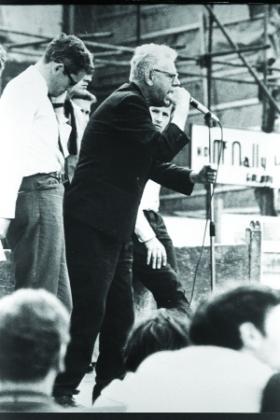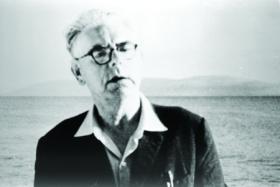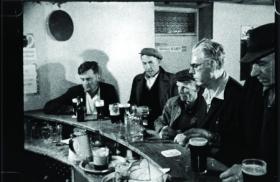TV Eye: Unsentimental realist
Published in 20th-century / Contemporary History, Issue 6 (Nov/Dec 2006), Reviews, Volume 14
‘Ó Cadhain was a political and cultural activist, a rebel whose career was bound up with the cultural difficulties of the formation of the modern Irish state.’
Unsentimental realist
RTÉ 1
Mairtín Ó Cadhain
Directed by Seán Ó Cualain and Macdara Ó Curraidein
TG4
There goes Cré na Cille
Directed by Breandán Ó hEithir (originally broadcast in 1976)
by Eamon O’Flaherty
This year has seen the centenary of the births of Samuel Beckett and Mairtín Ó Cadhain, Irish writers who have had an enormously different impact on modern literature but who have both been seen as innovators whose work broke the boundaries of literature in their traditions. Because all his work was in Irish, Ó Cadhain’s influence has been confined to the relatively small circle of those who can access his writings. Yet the claims made for him are such as to arouse a curiosity about the man and his work that goes far beyond the world of modern Irish literary history. Ó Cadhain was also a political and cultural activist, a rebel whose career, rather like Flann O’Brien’s, was bound up with the cultural difficulties of the formation of the modern Irish state. The two documentaries reviewed here present quite different perspectives on Ó Cadhain, not least because they are separated by a gap of 30 years. Taken together, they add up to an interesting portrait of one of the most intriguing figures in twentieth-century Irish-language literature.
Mairtín Ó Cadhain was born near Spiddal in Connemara in 1906. His ancestors had moved from Moycullen to the Connemara coast as landless labourers over a century earlier, and the family had painstakingly assembled a small farm out of the stony fields of the district, creating fertile ground by the laborious clearing of stones from the land and literally making soil by cutting huge quantities of seaweed from the shoreline. Ó Cadhain’s family were also steeped in the oral tradition. The interviews recorded in the 1976 film described his father’s ability as a storyteller, which no doubt influenced Ó Cadhain’s enormous output of stories based on the life of the Connemara Gaeltacht. Ó Cadhain was a bright student who escaped the life of subsistence farming by becoming a schoolmaster, returning to the Gaeltacht after teacher-training in St Patrick’s, Drumcondra. His early work was a commission by An Gum, the state publishing house, to translate Charles Kickham’s novel Sally Kavanagh, but he also began to write short stories based on the harsh realities of rural life. The first of these, and one of the few to have been translated into English, The Road to Bright City, contains the characteristic elements of his early writing—an unsentimental realism in describing peasant life and a sympathetic focus on the harshness of women’s lives in this society. ‘Fearg, fearg, fearg’ (anger, anger, anger) was one of the features of Ó Cadhain’s personality throughout his work and also spilled over into his political life.
From the beginning of his career Ó Cadhain was an activist. He joined the IRA in the 1920s and was also active in the Gaelic League. Like many radical republicans, he had a complex relationship with de Valera’s Fianna Fáil which deteriorated in the 1930s. In this period he was one of the organisers of Muinntear na Gaeltachta, which campaigned for better social conditions in the Gaeltacht and found an outlet in Seán Beaumont’s radical newspaper An tEireannach.  He was sacked from his teaching post in east Galway by the local parish priest in 1935, partly because of his outspoken admiration for James Connolly, and was interned in the Curragh in 1940. During his four years in the prison camp Ó Cadhain organised Irish classes and later began a new period of writing, which matured in the early post-war years after his release.
He was sacked from his teaching post in east Galway by the local parish priest in 1935, partly because of his outspoken admiration for James Connolly, and was interned in the Curragh in 1940. During his four years in the prison camp Ó Cadhain organised Irish classes and later began a new period of writing, which matured in the early post-war years after his release.
Gearóid Denvir identified four periods in Ó Cadhain’s literary life. The early short stories of Connemara life of the 1920s and 1930s were followed by a post-war period of activity that produced one of his most famous books, Cré na Cille, in which the themes were similar but Ó Cadhain was experimenting with form. A period of silence lasting from 1953 to 1961 was followed by a final period during which in a series of books, most famously An tSraith ar Lár, Ó Cadhain’s writing reflected other themes springing from his life in Dublin. After the war Ó Cadhain married and eventually found work in the translation department of the Oireachtas. This he found stultifying and it doubtless inspired his Kafkaesque satires on the civil service in later writing. But it was in this period that he deepened his engagement with European literature. Like many other Irish writers, Russian and French realism was an inspiration to Ó Cadhain.

Breandán Ó hEithir, director of the 1976 documentary.
He was also liberated from the editorial constraints of An Gum when he founded the independent Irish-language publisher Sairseil Agus Dill. Yet Ó Cadhain stopped writing for eight years after 1953, apparently depressed by what he saw as the terminal decline of the Irish language. By now there were many who realised the importance of his work and were also prepared to make allowances for the often gloomy side of his personality. A bright moment was Ó Cadhain’s appointment to a lectureship in Irish at Trinity College, Dublin, in 1956. Sympathetic Trinity supporters such as David Greene and Frank Mitchell managed to keep certain parts of Ó Cadhain’s CV from the older members of the college board, and Ó Cadhain entered into what proved to be the happiest period of his life.

‘Many who realised the importance of his work were prepared to make allowances for the often gloomy side of his personality.’
The final creative phase of Ó Cadhain’s career during the 1960s saw him produce a series of novels and stories that extended the range of his fiction. Some contributors plausibly suggested that Ó Cadhain’s pessimism about Irish was mitigated by the revival of activism in the 1960s. In organisations like Misneach, Ó Cadhain was able to join with other idealists to pursue his earlier commitment to justice for the Gaeltacht people and to campaign against the arid failures of the state’s commitment to the Irish-language revival.
Taken together, both films gave us important insights into this important but, outside a small circle, largely unknown Irish writer. The use of actors and animation to dramatise parts of Ó Cadhain’s work gave some sense of how interesting they might be. The problem remains that, in the absence of English-language translations of almost all his work, Ó Cadhain remains a closed book to most Irish people. Surely it is time for Irish-language scholars to revisit their long-standing moratorium on the translation of modern Irish literature into English?
Eamon O’Flaherty lectures in history at University College Dublin.
















